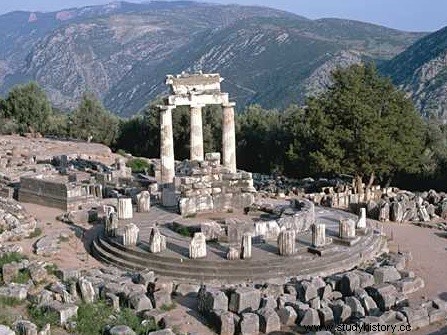 “Ancient Greece is the term given to the civilization that began around 700 BC. AD in Greece and its colonies and reached its peak in the 5th century BC. Whether in art, politics, literature, philosophy or science, the legacy of ancient Greece still influences our world. The Greek Civilization invented almost everything, starting with democracy. Yet it was to the rhythm of wars that the Greek cities lived. Despite their divisions, the Greeks were united by a common culture, religion and language. Greek culture will spread in Asia with the conquests of Alexander the Great, then in Europe at the time of Roman domination.
“Ancient Greece is the term given to the civilization that began around 700 BC. AD in Greece and its colonies and reached its peak in the 5th century BC. Whether in art, politics, literature, philosophy or science, the legacy of ancient Greece still influences our world. The Greek Civilization invented almost everything, starting with democracy. Yet it was to the rhythm of wars that the Greek cities lived. Despite their divisions, the Greeks were united by a common culture, religion and language. Greek culture will spread in Asia with the conquests of Alexander the Great, then in Europe at the time of Roman domination.
At the dawn of Greek civilization
During the ninth century BC, Archaic Greece emerged from the darkness or had plunged it with the demise of the Mycenaean civilization. A new wave of invaders, the Dorians, introduced the use of iron, which breathed new life into urban life. Cities evolved into independent city-states, ruled first by kings. As trade developed, rulers sent their citizens overseas to found merchant colonies.
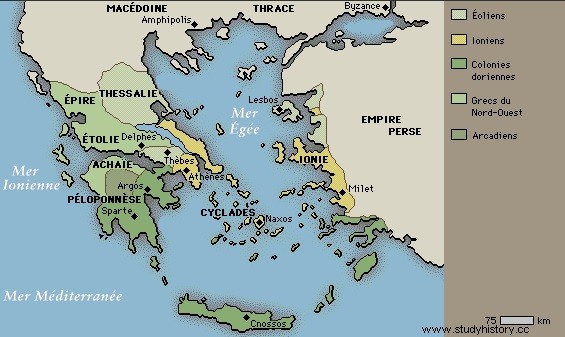 This migration allowed them to partially solve the problem of overpopulation of the peninsula, due in particular to the shortage of land cultivable. Important Greek cities then dotted the coast of Asia Minor (Anatolia), that of the Black Sea, Sicily and southern Italy, and Spain. Only the Phoenicians could compete with the Greek power.
This migration allowed them to partially solve the problem of overpopulation of the peninsula, due in particular to the shortage of land cultivable. Important Greek cities then dotted the coast of Asia Minor (Anatolia), that of the Black Sea, Sicily and southern Italy, and Spain. Only the Phoenicians could compete with the Greek power.
During the 9th and 8th centuries BC. Jesus Christ, a period that is best known to us through the stories of Homer and Hesiod, put in place some of the features that will distinguish the archaic period from classical Greece to come. Thus, alongside the rediscovery of writing and with the revival of the Greek religion, emerge social structures (very small territorial units headed by a basileus, a king, that is to say the one who has the richest domain, with social classes ranging from nobles, principals companions of the king, to slaves, excluded from all political life and from the army) and a system of values (based on hospitality and courage), characteristics of a common Greek culture.
Ancient Greece and the emergence of city-states
It had already been two centuries since the majority of the city-states of Greece, abandoning the monarchy, were ruled by aristocrats or heads of hereditary clans, with the exception of Sparta and Argos. Gradually the resentment of the citizens towards the nobility increased:the people demanded the right to decide on the way in which they were governed. Here and there revolutions broke out, led by charismatic leaders who, to gain the trust of the people, confiscated land from the rich to distribute it to the poor.
Tyrants rule without nobles, and sometimes even against them. Some prove to be wise rulers and increase the power of their city, like Polycrates (who reigns approximately in 535-522 BC), in Samos. The period of tyranny (c. 650-500 BC) corresponds to an era of cultural and economic development. Trade, particularly by sea, is increasing, and the use of money is becoming essential.
The development of cultural activities common to all Greek city-states was one of the great unifying factors in ancient Greece, despite the political fragmentation, alongside the language and to religion. Practices such as the Panhellenic Games organized in Olympia (Olympic Games), Delphi, Nemea and on the Isthmus of Corinth, contributed to the awareness by the Greeks of their belonging to the same civilization.
The tyrants, since such was their name, by abusing their authority themselves, became in turn the target of the vengeance of the people, determined to make themselves heard.
Agriculture in ancient Greece
In the Mediterranean environment there are strong natural constraints. The strongest constraint is the existence of a dry season in summer. The second constraint is to find an economic use for the mountains. They developed the first Mediterranean agriculture based on the Mediterranean trilogy. This system is based on three fundamental crops:cereals, vines and olive trees.
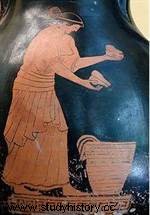 The two essential grains are barley and wheat. Barley is the first cultivated cereal. This predominance of barley is explained by the fact that barley is well adapted to the Mediterranean climate:barley needs little rainfall in the spring to reach maturity. Barley, a cereal that is planted for safety, is a subsistence cereal which, however, has a defect:it is difficult to make bread from it, and the consequence is that barley is consumed rather in the form of porridge:maza..
The two essential grains are barley and wheat. Barley is the first cultivated cereal. This predominance of barley is explained by the fact that barley is well adapted to the Mediterranean climate:barley needs little rainfall in the spring to reach maturity. Barley, a cereal that is planted for safety, is a subsistence cereal which, however, has a defect:it is difficult to make bread from it, and the consequence is that barley is consumed rather in the form of porridge:maza..
Wheat is grown more and more when you go to northern Greece. This wheat, compared to barley, is advantageous because it makes it possible to make bread (artos) and it is a food for struggle. This food will characterize the diet of city dwellers, of urban strata. This wheat has a defect:it is more sensitive to spring drought and sowing wheat is an economic risk, it is therefore a speculative cereal.
These cereals are grown by biennial crop rotation, that is, it is based on a two-year site. The first year is the fallow year. This year is when the land is not sown. The fallow is regularly plowed. This plowing is done using the plow, a wooden implement, light and adapted to the Mediterranean soil. The second year, we proceed to sowing in autumn and harvesting in spring. For these spring harvests, we start with barley in April, and continue with wheat in May/June.
In this cultivation of Greek cereals, a low yield is obtained, since relatively little fertilizer is used. This low yield has resulted in the fear of the food crisis. Cereals are under the protection of a particular deity:the goddess Demeter.
At the beginning of the Archaic period, the olive tree was only a shepherd's tree, a garden tree. During the Archaic period, this olive growing developed and there was now mass olive growing in certain regions of the Greek world, such as in the region of Attica or the North-West of the Peloponnese. It is a tree that does not fear drought. This culture requires a large initial investment, which comes from the fact that olive trees take a long time to reach adulthood. Once mature, however, the tree did not require any work. The only time when olive growing requires labor is during the harvest, which takes place from October to December.
Oil production requires expensive presses and technological progress has been observed with the manufacture of increasingly complex presses. Olive oil had multiple uses. It was used mainly for food, but also for lighting, for hygiene. The patron goddess of the olive tree was Athena.
Viticulture required a lot of work:the vines had to be pruned. This viticulture also required an abundant workforce at harvest time. Faced with this demand for labour, it also had advantages since this crop could contain interesting additional income for the peasants. Wine-growing regions had turned to the production of great wines intended for foreign trade. One of the most expensive was wine from the island of Thasos in northern Greece. Vine and wine are associated with Dionysus. There was an elite consumption of wine as part of the banquet (the symposium) which was a gathering of men following a meal, in the evening, around the Crater. It was a practice of sociability of the elites. The Greeks considered drinking pure wine to be barbarism:it was mixed with water.
The artisanal sector
The craft was practiced in the oikos. There were also craftsmen in the village (blacksmiths), many craft workshops are however located in town, first in the specialized districts where they are grouped by trades (eg:Ceramics district in Athens), around the agora or on the agora, in private houses (on the ground floor).
From the point of view of social status, artisans are often non-citizens:
- metics
- oikounte chôris:slaves who live independently of their master, who have been taught a trade. It is an investment because they know a trade and are placed in a shop whose income essentially goes to their master. These slaves looked a lot like free men.
The city had a rather contemptuous look at those who worked in this sector of the economy.
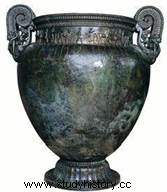 The ergastèrion was the basic unit in the field of craft production. Its function was threefold:a workshop (place of production), but also a place of marketing (a shop), and finally this unit had a third function which was the place of residence of the craftsman with his workers. A workshop occupied only a small number of people. The average ergasterion employed four to five people, including the boss. Larger workshops are still developed, notably in Athens, a workshop belonging to a metic:Kephalos of Syracuse. In this workshop, shields were made with a workforce of 120 slaves, which was important for the time.
The ergastèrion was the basic unit in the field of craft production. Its function was threefold:a workshop (place of production), but also a place of marketing (a shop), and finally this unit had a third function which was the place of residence of the craftsman with his workers. A workshop occupied only a small number of people. The average ergasterion employed four to five people, including the boss. Larger workshops are still developed, notably in Athens, a workshop belonging to a metic:Kephalos of Syracuse. In this workshop, shields were made with a workforce of 120 slaves, which was important for the time.
Since 1890, there are mainly two major schools of interpretation of economics in antiquity:the modernists and the primitivists. The modernists (Michael Rostovtzeff) have a great idea of development based on craftsmanship and long-distance trade, also on the birth of the first banks in history. They therefore explain the development of crafts and finance through a complex organization. This school of modernists has now been replaced by that of primitivists...
The primitivists (Moses Finley) highlight a misunderstanding of the specificity of economic phenomena among the Greeks, subsistence agriculture, marginalization of merchants, blocking of techniques in reason for the employment of slaves.
The Greeks had no word to talk about economy, so they could not found an economic policy. The ideal of the Greek city was the ideal of autarky:the cities never developed their foreign trade. Not only was it not developed, but the merchants were always viewed with suspicion. Finally, still according to this theory, there would have been a blockage of techniques:no invention of machines given the presence of slaves.
Today the theory of primitivists has been revised. The example of the press revealed technical innovations.
Grand commerce
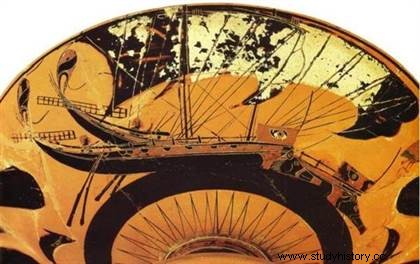 The goods traded were luxury goods (oil from Athens, wine from Thasos, wool from Miletus), each city had a specialty which it exported. Also strategic materials (wood from Macedonia, to design warships), this wood was exported to Athens. The slave trade was developed in Asia Minor, at Pont Euxin, and in Syria, mainly. It develops in the classical period, the Greeks imported slaves who came from peripheral regions. Finally, cereals, and rather wheat, integrated this trade, the supply was made at Pont Euxin, in Sicily and in Egypt.
The goods traded were luxury goods (oil from Athens, wine from Thasos, wool from Miletus), each city had a specialty which it exported. Also strategic materials (wood from Macedonia, to design warships), this wood was exported to Athens. The slave trade was developed in Asia Minor, at Pont Euxin, and in Syria, mainly. It develops in the classical period, the Greeks imported slaves who came from peripheral regions. Finally, cereals, and rather wheat, integrated this trade, the supply was made at Pont Euxin, in Sicily and in Egypt.
Land transport was slow and expensive, and the multiplicity of borders between cities encouraged maritime trade. Trading ships (round ships) were propelled by sail, and they had a hull to put the cargo. These ships sailed according to a seasonal schedule. The Greeks distinguished two main seasons in the year:during the winter, the sailors feared the storms, during the winter there were therefore never long journeys, it was the so-called season of the “closed sea”. From May this navigation intensified, it lasted until September, period of the "open sea". This period was when trade was most intense.
The emporion was a city port. The most famous was the port of Athens:Piraeus. It was founded by an Athenian strategist, Themistocles in 493/492 and became a commercial port, it was initially a port of war. It had three basins, but the trading port was on the large basin (Kantharos). A geographical separation between the port and the city was quite normal in the Greek cities. In some colonial cities, the port was directly in the city (asty), for example Milet (Asia Minor) or Marseille.
Among the actors of big business (the world of the emporion), we could find the nauclere who was the owner and captain of a merchant ship and who rented it to sellers. The shipwreck was the equivalent of a shipowner, he was however on board his ship. In classical times, the nauclères owned a single trading vessel. Their social status was little considered in the city because they were not particularly rich in antiquity. The emporos was the owner of the goods, the merchant. He rented the ship from a shipwreck, he traveled with his goods, accompanied him.
These merchants were held in low regard in society, they led adventurous lives and took risks. They were therefore also little considered because they are most often foreigners. The moneylender dealt money at interest to the emporoi. These backers stayed at home, there was no physical risk for them. They demanded extremely high interest rates. Donors and emporos entered into a maritime loan contract, which was risky:in the event of shipwreck or storm, the emporos had no obligation to repay. Socially, these backers were not looked down upon.
Finally, let's not forget the kapèlos who was the retailer who bought goods wholesale at the emporion and resold them at retail on the agora to consumers. They were accused of being speculators and were the victims of popular riots.
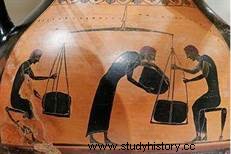 For cities open to the outside (like Athens), autarky was the balance of imports by export, but without seeking a positive trade balance. It was also necessary to ensure the provisioning of the citizens and to limit the impact of food shortages (intervention of the sitophylaques:new magistracy). It was also necessary to increase tax revenues from maritime trade, in particular that of pentekostè (tax of 2% which brought in the most to the budget of the city), and to encourage the installation of merchants.
For cities open to the outside (like Athens), autarky was the balance of imports by export, but without seeking a positive trade balance. It was also necessary to ensure the provisioning of the citizens and to limit the impact of food shortages (intervention of the sitophylaques:new magistracy). It was also necessary to increase tax revenues from maritime trade, in particular that of pentekostè (tax of 2% which brought in the most to the budget of the city), and to encourage the installation of merchants.
The currency of ancient Greece
Currency was invented around 600 BC and spread throughout the Greek world in the 6th and 5th centuries BC. This diffusion was a major fact in the history of the economy of the West. It was a revolutionary novelty.
In ancient Greece, the economy was just one function among many. It was first of all the symbol of the independence of the city. Money was also a legal tool:in Greek law, it allowed fines. It was also an instrument of internal and external policy. Inside, it made it possible to pay compensation to citizens for their participation in political life. Also an instrument of foreign policy because it was used to pay mercenaries and allies, and was used to exact tribute from dominated cities.
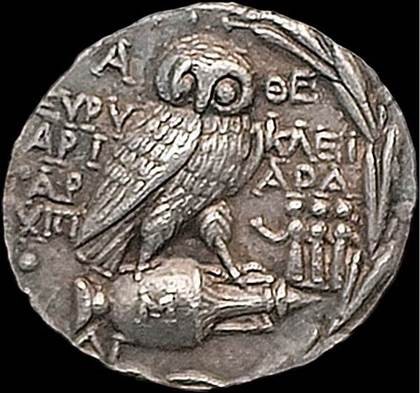 The currency type was the set of iconographic patterns and legends of a currency. Each city had its monetary type which characterized it. For Athens it was, on one side of the head of Athena and on the other side of the owl. The drachma is divided into six obols and 1 drachma was worth a day of skilled labor. The stater represented 2 drachmas, the tetradrachm 4 drachmas. Beyond these subdivisions, there were units of account (corresponding to no coin):the Mine (100 drachmas) and the Talent (6000 drachmas). These coins were made of precious metals. The most common was silver found in the mines of Laurion and the Cyclades (Siphnos). The second precious metal used was an alliance of gold and silver, it was called electrum. This alloy was found in Asia Minor, whose cities were the first to use it, such as Cyzicus and Phocaea.
The currency type was the set of iconographic patterns and legends of a currency. Each city had its monetary type which characterized it. For Athens it was, on one side of the head of Athena and on the other side of the owl. The drachma is divided into six obols and 1 drachma was worth a day of skilled labor. The stater represented 2 drachmas, the tetradrachm 4 drachmas. Beyond these subdivisions, there were units of account (corresponding to no coin):the Mine (100 drachmas) and the Talent (6000 drachmas). These coins were made of precious metals. The most common was silver found in the mines of Laurion and the Cyclades (Siphnos). The second precious metal used was an alliance of gold and silver, it was called electrum. This alloy was found in Asia Minor, whose cities were the first to use it, such as Cyzicus and Phocaea.
Finally the third monetary metal was gold. There was little use of gold to strike coins, this was explained by the fact that there were few gold mines in the Greek world. The only gold mines were in two regions:Thrace and Macedonia. These two regions were controlled by the Kingdom of Macedonia. These monetary metals had an intrinsic value, which meant that the price of gold and silver directly affected the value of silver. You couldn't mint coins with pure gold or silver. To make durable coins, a little copper had to be added. The percentage of precious metal in a coin is called the alaw.
The currency therefore had a specific weight:the Euboïco-Attic standard. For example, a tetradrachm (4 drachmas) weighed 17.2g. The parts used daily were small and light. This had the consequence that the monetization of small businesses was delayed. From the end of the 5th century, we began to use bronze coins, indeed bronze is a base metal (without intrinsic value). The Greeks invented fiduciary money, that is to say a currency whose value was determined only by confidence in the issuing state. From the 4th century, bronze coins became widespread in the interior of Greek cities. The Greek world had no monetary unit in the classical period, each Greek city having its own currency.
Finance professions
Very quickly in Greece, we see the profession of money changer appear, at the end of the 6th century in Byzantium. Around 420, certain money changers diversified their activity and became the first bankers in history. It was probably in Athens that this invention of banking took place. A banker was a "trapezite" combining three different activities:
Change:they continued to change the foreign currencies that were brought to them.
Custody or payment deposit:the custody deposit was a deposit where money was left with the banker for safekeeping. It did not earn interest and even on the contrary there were custody fees. One could also make deposits of guard in large sanctuaries, the example of the sanctuary of Artémis shows it. The payment deposit was made when an individual paid a large sum to another individual and in this case, it happened that these individuals decided to go through a banker who controlled the value of the coins and the accuracy of the sum.
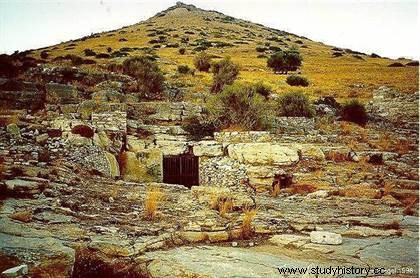 Bank credit (rate of more than 10% per year) was granted only for large sums to wealthy people. Loan rates were very high, at least 10% per year. On the other hand, modest people who needed a little money to be lent to them had to turn to other financial professionals:loan sharks. Banks have never created networks. Bankers had a special place in the society of that time, because they were often very rich and therefore influential people, but also because they were often metics and slaves. We can therefore see that the bank has enabled rapid social ascents, this is the case of Pasion.
Bank credit (rate of more than 10% per year) was granted only for large sums to wealthy people. Loan rates were very high, at least 10% per year. On the other hand, modest people who needed a little money to be lent to them had to turn to other financial professionals:loan sharks. Banks have never created networks. Bankers had a special place in the society of that time, because they were often very rich and therefore influential people, but also because they were often metics and slaves. We can therefore see that the bank has enabled rapid social ascents, this is the case of Pasion.
Regarding finance in the city, in the exceptional case of Athens there were the revenues of the Laurion and tribute paid by the allies of Athens. Athens was a quite exceptional city among the Greek cities of the time:the Laurion mines officially belonged to the city. Athens was at the head of an Empire, and the allies paid her a tribute which was a second source of income for the city. Athenians were able to make do with relatively low taxation, Athens did not need to ask citizens to pay regular direct taxes. The metics, on the other hand, had to pay one:the metoikion. The metoikion was 12 drachmas per person, paid by metics, 6 drachmas for women. There were a lot of metics in Athens.
In indirect taxes (taxes), there was the pentekostè on large trade (the "fiftieth", 2% tax on the value of Athenian imports and exports) which brought in a lot because the port of Piraeus was a very busy port. Eponia were a tax on agora transactions. The liturgy was a financial charge for a public service imposed by the city on a rich individual, it was the example of the trierarchy which consisted in the financing of the Athenian navy and the triremes, the liturgist was called the trierarch, each year a wealthy individual was trierarch and officially took command of this trireme which he had to pay for upkeep out of his own pocket. The trierarchy cost several thousand drachmas. Other liturgies were used to finance religious festivals.
This was the case of the Eisphora, a wealth tax paid by members of the first three Solonian classes instituted in 428/7 BC
Athenian democracy
It was Athens that first consented to the sharing of power. At the end of the 6th century, political reforms favored the emergence of a new form of government:democracy. In 508-509 BC. AD, Cleisthenes, a member of an aristocratic family, had a series of measures adopted based on democratic principles, which gave a framework to the Athenian institutions of the 5th and 4th centuries BC. J.-C. and make him the true "father" of democracy.
Athenian democracy allowed citizens to express themselves through voting on all major decisions such as declarations of war or government spending. They could also elect their civil and military representatives, and decide on the exile of all notables deemed too powerful. If in the four corners of the world the current democracies are inspired by the Greek model, none concedes as much power to the citizens as did the ancient Athenian city. However, the right of citizenship was reserved for free men over the age of twenty, born in Athens of Athenian parents. The other residents – women, slaves and foreigners (the majority of the population) – were deprived of it.
Persian Wars and Civil Wars in Ancient Greece
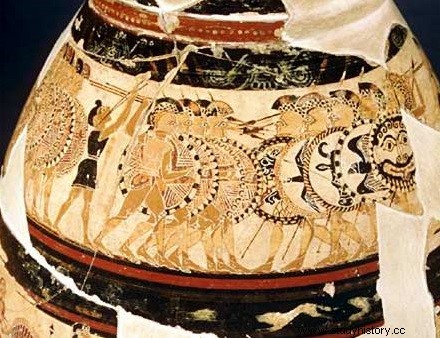 Fierce rivalry between the city states that sought to dominate Greece and the Aegean basin resulted in incessant wars . On the battlefields, the Greeks distinguished themselves by their bravery and discipline. Armed with spears, infantry fought in a defensive formation called a phalanx. Every healthy man with the means to equip himself with weapons and protection had to join the army of his city in the event of a conflict. However, it was the city of Sparta that provided the best soldiers. At the age of seven, all the boys left their families to receive state education. This consisted mainly of sports and military training.
Fierce rivalry between the city states that sought to dominate Greece and the Aegean basin resulted in incessant wars . On the battlefields, the Greeks distinguished themselves by their bravery and discipline. Armed with spears, infantry fought in a defensive formation called a phalanx. Every healthy man with the means to equip himself with weapons and protection had to join the army of his city in the event of a conflict. However, it was the city of Sparta that provided the best soldiers. At the age of seven, all the boys left their families to receive state education. This consisted mainly of sports and military training.
Their rigorous training allowed the Greeks to repel the Persian attacks three times on land and at sea. In 492 BC, it was the climatic conditions that were right invaders. Two years later the Athenian army triumphed at the Battle of Marathon. Then in 479-480 BC, the huge army of Xerxes made up of 200,000 men and 1,000 ships had to bow before the much more modest allied troops from Athens and Sparta. After a first encounter in the parade of Thermopylae, defended by the Spartan Leonidas I, a naval battle took place at Salamis in 480. It was won by Themistocles and Eurybiades. The total defeat of the Persians took place at Plataea, in 479 BC. AD
The "century of Pericles"
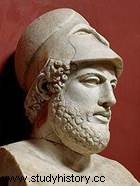 Undisputed winner of the Persians, the city-state of Athens gained immense prestige from the Persian Wars and became the city the most important of the Aegean world, at the head of the league of Delos. Furthermore, the conflict demonstrated the growing importance of naval power, following the decisive Battle of Salamis. The army of Sparta, until now the greatest military power in ancient Greece and the ally of Athens, loses its supremacy to the benefit of the Athenian fleet, which dominates the Aegean Sea.
Undisputed winner of the Persians, the city-state of Athens gained immense prestige from the Persian Wars and became the city the most important of the Aegean world, at the head of the league of Delos. Furthermore, the conflict demonstrated the growing importance of naval power, following the decisive Battle of Salamis. The army of Sparta, until now the greatest military power in ancient Greece and the ally of Athens, loses its supremacy to the benefit of the Athenian fleet, which dominates the Aegean Sea.
A period of political, cultural and artistic domination opens for Athens, which reaches its peak under Pericles. It strengthens the democratic institutions of the city, which is, thanks to the treasure of the league of Delos, embellished and endowed with new monuments:most of the buildings of the Acropolis date from this period. Athens radiates throughout the ancient world, both culturally and artistically - with authors like Aeschylus, Sophocles, Euripides, philosophers like Socrates and Plato, historians such as Thucydides and Herodotus, sculptors like Phidias - and economically, Piraeus having become the hub of Mediterranean trade.
Athens' foreign policy causes its downfall. From a confederation of allies, the league of Delos is transformed into an unequal empire where the cities which revolt are mercilessly punished. Sparta, jealous of the prosperity of Athens and eager to recover its prestige, took the opportunity to create a confederation of cities hostile to Athenian imperialism. Sparta and Athens had a growing hostility that culminated in the Peloponnesian War (431-404 BC), which ended with the defeat of Athens in 404.
Weakened by these repeated conflicts, the cities yielded easily to the rising power of Macedonia to the north. In 338 BC, King Philip II, a military genius, seized all of Greece after the Battle of Chaeronea. He collects the heritage of Greek civilization which will be widely disseminated by his son Alexander the Great over his many conquests.
The legacy of Greek civilization
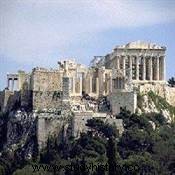 Without writing, none of this would have been possible. While other ancient systems used different symbols, the Greeks adopted a phonetic alphabet of 20 characters. L’éducation jouait un grand rôle dans la démocratie :les hommes au pouvoir devaient déployer tous leurs talents d’orateur pour convaincre du bien-fondé de leur politique. On enseignait l’éloquence dans des écoles et l’usage de l’écriture favorisait la circulation des idées. L’éducation physique n’était pas négligée pour autant :l’athlétisme, la lutte et la boxe figuraient parmi les disciplines privilégiées. Lors de grandes manifestations sportives comme les jeux olympiques, une trêve était imposée aux cités en guerre pour permettre de s’y rendre en toute sécurité.
Without writing, none of this would have been possible. While other ancient systems used different symbols, the Greeks adopted a phonetic alphabet of 20 characters. L’éducation jouait un grand rôle dans la démocratie :les hommes au pouvoir devaient déployer tous leurs talents d’orateur pour convaincre du bien-fondé de leur politique. On enseignait l’éloquence dans des écoles et l’usage de l’écriture favorisait la circulation des idées. L’éducation physique n’était pas négligée pour autant :l’athlétisme, la lutte et la boxe figuraient parmi les disciplines privilégiées. Lors de grandes manifestations sportives comme les jeux olympiques, une trêve était imposée aux cités en guerre pour permettre de s’y rendre en toute sécurité.
Entre le VIe et le IVe siècle avant notre ère, en dépit des guerres qui se succédaient sur leur territoire, les grecs dominèrent la mer méditerranée. Ils maîtrisaient la sculpture, la peinture et l’architecture. La tragédie et le théâtre s’épanouirent. La littérature, mais aussi la mythologie grecque continuent d’inspirer aujourd’hui les artistes. Quant aux philosophes athéniens (Socrate, Platon, Aristote) ils posèrent les jalons de la pensée européenne. Les grecs rédigèrent les premiers ouvrages historiques, firent progresser les mathématiques et la géométrie, et élevèrent la médecine au rang de discipline scientifique…
La civilisation romaine qui suivit la civilisation grecque fut par bien des aspects une continuation de la civilisation hellénistique.
Bibliography
- Histoire du monde grec antique de François Lefèvre. poche, 2007.
- Amouretti et Ruzé :Le monde grec antique. Hachette 2008.
- La Grèce antique de Georges Tate. Hachette, 2007.
- Le Siècle de Périclès. Collectif. CNRS Editions, 2010.
